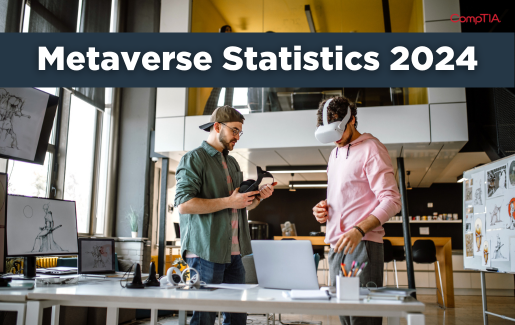 Although the metaverse was first mentioned in Neal Stephenson’s fictional novel Snow Crash in 1992 as a successor to the internet, the concept of a metaverse today has become more prevalent, a constantly evolving ecosystem incorporating virtual reality (VR), augmented reality (AR), internet of things (IoT), artificial intelligence (AI)—and much more.
Although the metaverse was first mentioned in Neal Stephenson’s fictional novel Snow Crash in 1992 as a successor to the internet, the concept of a metaverse today has become more prevalent, a constantly evolving ecosystem incorporating virtual reality (VR), augmented reality (AR), internet of things (IoT), artificial intelligence (AI)—and much more.
Why now? The COVID-19 pandemic forced many people to conduct more virtual business meetings and many people started to interact more online than in the real world. And the trend has continued as many workers have remained remote.
What Is the Metaverse?
VR gaming platforms and headsets have helped to popularize the concept of online worlds and communities and IoT and AI technologies are being used to help solve business problems in industries including agriculture, construction and food manufacturing. But a more official description of the metaverse is the convergence of the physical and digital realms resulting in a 3D virtual space where human beings work, shop and live using avatars that move freely from one experience to another using our identities and our own money.
It may not be long before people will feel comfortable applying for jobs, earning a living, meeting friends, going to concerts, shopping and even getting married within the virtual capabilities of the metaverse. Virtual concerts are already huge in the metaverse—with tens of millions of fans tuning in to watch Ariana Grande, Travis Scott and more.
According to Gartner, 25% of people will spend at least an hour per day in the metaverse by 2026 and by the same year, 30% of all organizations in the world will have products and services ready for the metaverse.
The Metaverse Market Size
There are many different forecasts for the growth of the metaverse:
- According to Earthweb the global metaverse market was valued at $61.8 billion in 2022 and will reach $426.9 billion in 2027 with a compound annual growth rate (CAGR) of 47.2%. It currently has more than 400 million monthly active users.
- Statista predicts that revenue in the metaverse will show CAGR growth of 36.7%, resulting in a projected market of $490.4 billion by 2030.
- Bloomberg predicts that the metaverse will be worth $800 billion by 2024.
- Market watcher McKinsey & Company believes it will be even bigger, predicting, the metaverse economy could reach $5 trillion by 2030. It says more than $120 billion poured into the metaverse in 2022, more than double the $57 billion in 2021.
Key Metaverse Statistics
Earthweb shared some stats on where companies and business that have invested in the metaverse have placed their bets so far:
- 53% have invested in cryptocurrencies
- 44% have invested in non-fungible tokens (NFTs)
- 40% have invested in the work environment and remote working
- 30% have invested in branding and positioning
- 27% have invested in product purchasing
- 24% have invested in gaming
- 24% have invested in product creation
- 18% have invested in real estate
- 15% have invested in entertainment
3 Ways to Access the Metaverse
There are a few different ways to access the metaverse right now:
- Virtual Reality: Simulated 3D environment that allows users to interact with a virtual surrounding
- Augmented Reality: Less immersive than VR but a growing market, some examples include Pokemon Go and Google Glass
- Gaming Platforms: Roblox, Decentraland and Minecraft can be accessed by internet users through browsers or mobile devices and an internet connection and products can be bought using virtual currency
How Can Business Leaders Harness the Metaverse?
McKinsey also predicts that more than 50% of live events will be held in the metaverse by 2030 and more than 80% of commerce could be impacted. That means leaders will need to learn about the metaverse and define the role they want it to play in future growth.
Some business tips from Deloitte include:
- Don’t underestimate the potential: Formulate a strategy but keep it flexible enough to adapt
- Take the long view: The metaverse is still several years away from being mainstream but take a long-term view on investment and consider KPIs around consumer and employee engagement
- Focus on demand and what motivates users: Create captivating content and engaging experiences
- Commit to a responsible metaverse: Consider sustainability implications, privacy, security and ensure these become part of your long-term strategy
Related content: 6 Reasons Why We’re Ready for the Metaverse
The Metaverse Market Opportunities
See which industries and sectors are already taking advantage of the metaverse:
Healthcare: Some hospitals are already using VR and AR to train for common medical procedures.
Safe Emergency Services Training: VR is being used to train fire departments, emergency service personnel and police offers in how to handle risky operations, but in a safe environment.
Enterprise: Enterprises are using the metaverse to add realism to remote work experiences including setting up 3D rooms for employee collaboration.
Education: Schools are using VR experiences to give students a more immersive education, bringing the classroom to life – another market that was accelerated by the global pandemic.
Retail: According to NielsenIQ global research, 51% of consumers said they would use AR/VR to assess products before purchasing and 61% said they would rather shop with retailers that offer AR experiences.
Manufacturing: Many manufacturers in trades such as construction and landscaping are already offering customers, both commercial and consumer, an immersive VR experience before they buy.
Social media marketing: Facebook is still the most popular social media platform, but TikTok is set to reach 834 million global downloads in 2023 and BeReal has seen 73 million global downloads. Marketing content needs to reflect this trend towards short-form/bite-sized content and it is not something ChatGPT can be relied upon to do.
Related content: The Metaverse Is Now: AR/VR Use Cases
The Metaverse Forecast: Where Is it Going?
It’s hard to say what the ultimate impact of the metaverse will be, but drivers for future growth are expected to include:
- AI
- IoT
- Extended reality
- Brain computer interfaces
- Blockchain
- Edge computing
- 3D modeling
Working in the Metaverse
Working in a metaverse environment may seem odd or futuristic, but possible benefits could include:
- Better teamwork and collaboration
- Appeal to a younger workforce, engaging Gen Z and attracting new talent
- Faster learning through interactive gameplay and simulations
- Sustainability factors, including the ability to assess operations without having to travel
Related content: Why the Metaverse Will Matter to IT Pros
How Safe Is the Metaverse?
As with any realm, physical or virtual, there are always going to be threats and malevolent individuals looking to exploit vulnerabilities. Some security risks in the metaverse include:
- A new platform for cybercriminals to perpetrate phishing and ransomware
- Privacy under General Data Protection Regulations (GDPR)
- Identify theft
- Intrusive data collection
- Fraudulent platforms
- Exploitation of minors
- User-to-user privacy issues
How Can You Protect Yourself in the Metaverse?
Just like there are ways to protect yourself in the physical world, there are measures you can take to prevent cybercrime in the metaverse:
- Consult trusted IT security advisors
- Regularly train staff to watch out for threats
- Always remain alert and informed of latest security trends
- Join industry groups that will inform members of the latest threats/scams
While the metaverse sounds like a very futuristic concept—the reality is that’s it’s already here. The question is how will it evolve? Only time will tell.
Interested in what’s coming?
Participate in the conversation when you join a CompTIA Technology Interest Group.

 Add CompTIA to your favorite RSS reader
Add CompTIA to your favorite RSS reader

